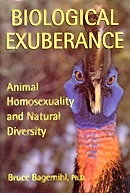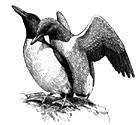
Gay/Lesbian/Feminist Bookstores Around the Country
The Mostly Unfabulous Homepage of Ethan Green
![]()


Biodiversity = Sexual Diversity
From Biological Exuberance
Scientists are beginning to find evidence that this diversity in social and mating systems contributes directly to the "success" of a species. For instance, among great bustards (a large, storklike bird found in southern Europe and North Africa), flexibility in heterosexual mating systems gives the bird a greater adaptability, enabling them to cope with difficult or variable ecological conditions.
And in some species, homosexuality itself appears to be associated with environmental or social changes in ways that are suggestive but (so far) poorly understood. Male pairing in Golden Plovers, for example, is claimed to be more prevalent in years when severe winter snowstorms have "disrupted" heterosexual pairing, while female coparenting among Grizzlies appears to be characteristic of animals living in conditions of environmental or social flux. In Ostriches, homosexual courtships may be linked to unusually rainy seasons that alter the species' overall sexual and social patterns. Likewise, same-sex pairs in Ring-billed and California Gulls are more common in newly founded colonies that are experiencing rapid expansion, while homosexual activities in Rhesus and Stumptail Macaques (and a number of other primates) are often associated with changes in the composition or dynamics of the social group.
 |
| A male Common Murre attempting to forcibly copulate with another male Illustration by John Megahan, © 1999. |
The macaques' sexual behavior includes both hetero- and homosexual aspects as part of the "normal" pattern. Protocultural variations of some of these patterns have already been discussed but it is well to remember the extreme variation in behavior that characterizes individuals and groups of primates. This plasticity of behavior has apparently played a major role in the evolutionary success of primates by allowing them to adapt to a variety of social and environmental conditions ... The variability and plasticity of the behavior ... suggests an optimistic or "maximal view of human potentialities and limitations" ... rather than a pessimistic or minimal view of man as a biological machine functioning on the basis of instinct. This minimal view based on the fang-and-claw school of Darwinism finds little support in the evidence of protocultural evolution in nonhuman primates.
This is not to say that such plasticity always has an identifiable "function" in relation to specific environmental or social factors (even though a few such "functions" can be discerned in specific cases, as we saw in previous chapters). Behavioral versatility is best regarded as a manifestation of the larger "chaotic ordering" or non-linearity of the world, rather than merely a response to it. A broader synergy is involved, a pattern of overall adaptability that can be realized in ways that do not necessarily entails any literal "contribution" to reproduction or any straightforward "improvement" in an animal's well-being. In other words, it is the presence of behavior flexibility in a system that is as valuable, if not more so, than its actual concrete "usefulness" or "functionality."
Taken together, these observations -- of sexual diversity, and the strength imparted by such sexual variability -- lead to an important conclusion. The concept of biodiversity should be extended to include not only the genetic variety, but also the systems of social organization found within a species or ecosystem. In other words, sexual and gender systems are an essential measure of biological vitality. The more diverse patterns of social/sexual organization that a species or biological system contains -- including homosexuality, transgender, and nonreproductive heterosexuality -- the stronger that system will be.
Mating and courtship patterns are, after all, as much a part of the "complexity" of an ecosystem as the number of species it contains -- and same-sex activity is an integral part of those mating and courtship systems in many animals. It stands to reason, then, that a rich mosaic of different social patterns should increase the vitality of a system, even when such patterns themselves are apparently "unproductive" or are found in only a fraction of the population.
In a rain forest that contains many hundreds of thousands of species of mammals, birds, insects, plants, and so on, the "purpose" of yet one more kind of beetle may be difficult to see -- except when understood in terms of its contribution to the overall complexity and vitality of the environment. Similarly, the "function" of a particular social or sexual behavior such as homosexual courtship or heterosexual reverse mounting may seem minimal or even nonexistent at the level of a particular species or individual. But its contribution to the overall strength of the system is independent of such "utility" (or lack thereof) and is also independent of the proportion of the population that participates in it.
Every individual, every behavior -- whether productive or "counterproductive," comprising 1 percent or 99 percent of the population -- has a part to play. Its roles is not in the tapestry of life, but as the tapestry of life: its existence is its "function." Biological destiny is intrinsically valuable, and homosexuality/transgender is one reflection of that diversity.
Sounds good, right? Read more:
- Intro, Biological Exuberance: Now that's a wild kingdom.
- Formidable Fathers and Supernormal Mothers: Queer animals make great parents.
- Ritual: Guess which humal ritual began as monkey diddling.
- The Perversion of Scientific Discourse: Why would some experts call animals "immoral" or "sinful."
- Why Biological Exuberance?: Author Bruce Bagemihl explains the thoughts behind the book.
Copyright © 1999 Bruce Bagemihl.
 Back
to the Stonewall Inn
Back
to the Stonewall Inn 